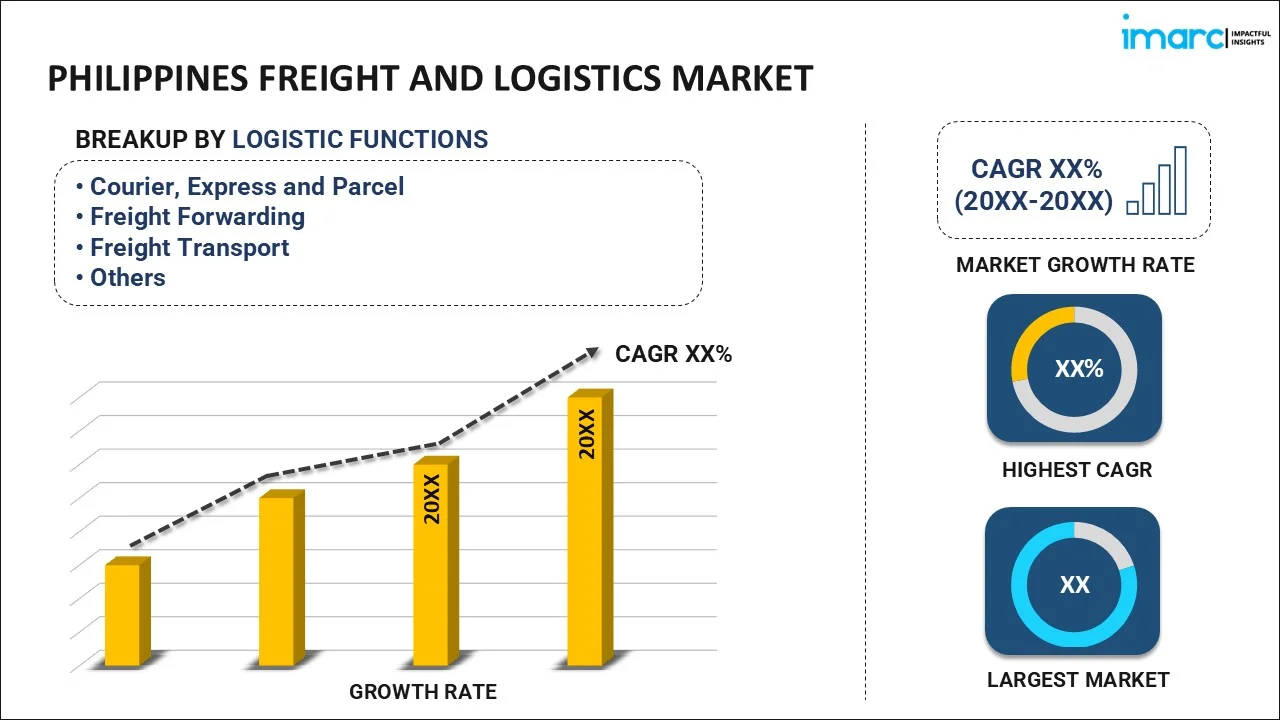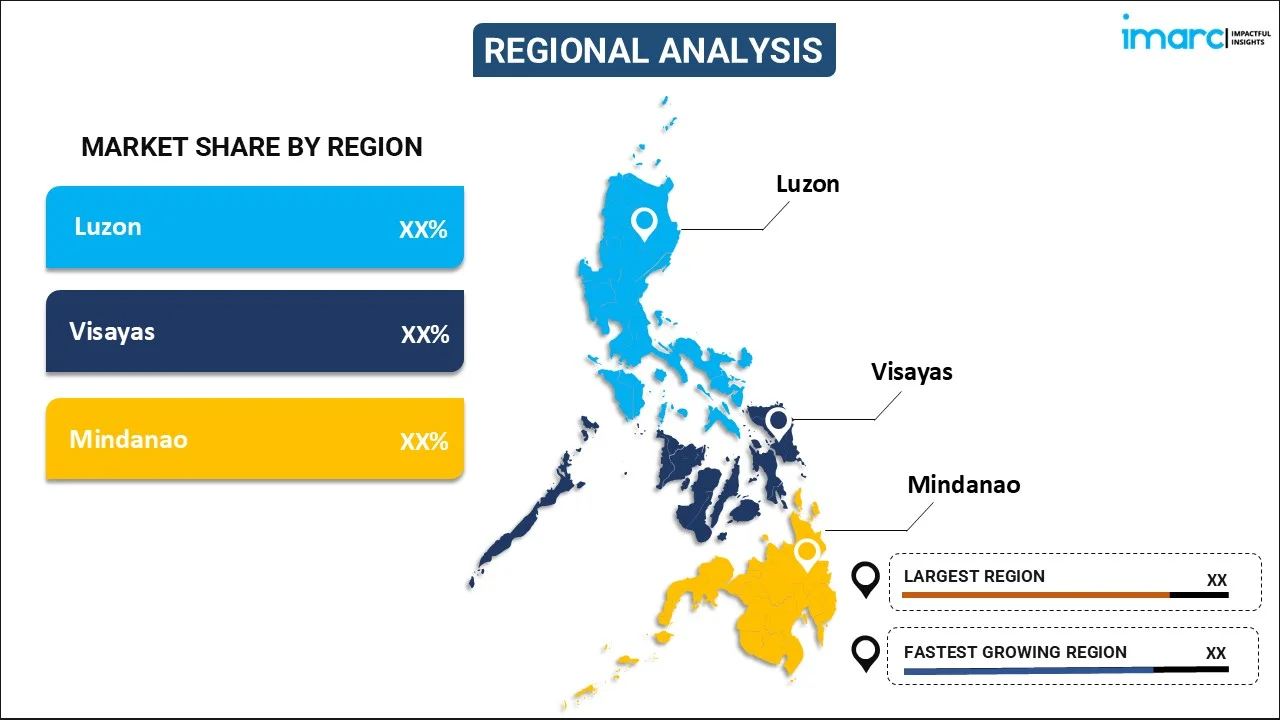
Philippines Freight and Logistics Market Size, Share, Trends and Forecast by Logistics Function, End Use Industry, and Region, 2025-2033
Philippines Freight and Logistics Market Overview:
The Philippines freight and logistics market size reached USD 18.03 Billion in 2024. Looking forward, IMARC Group expects the market to reach USD 31.20 Billion by 2033, exhibiting a growth rate (CAGR) of 5.81% during 2025-2033. The market is propelled by the growing e-commerce industry and online retail demand, infrastructure development and government initiatives, expansion of international trade and exports, and increasing demand for cold chain logistics in the food and pharmaceutical sectors.
|
Report Attribute
|
Key Statistics
|
|---|---|
|
Base Year
|
2024 |
|
Forecast Years
|
2025-2033
|
|
Historical Years
|
2019-2024
|
| Market Size in 2024 | USD 18.03 Billion |
| Market Forecast in 2033 | USD 31.20 Billion |
| Market Growth Rate (2025-2033) | 5.81% |
Philippines freight and logistics Market Trends:
Growing E-Commerce and Online Retail Sector
The rapid expansion of e-commerce in the Philippines is a major driver of the freight and logistics market. Growing smartphone penetration has fueled online shopping, increasing the need for efficient logistics solutions. E-commerce platforms require fast and reliable delivery networks, prompting logistics companies to enhance their operations with innovative strategies. Same-day and last-mile delivery services have become essential, driving investments in fleet management and distribution centers. Businesses are also streamlining operations by partnering with third-party logistics providers to expedite deliveries. Additionally, cross-border e-commerce is gaining momentum, with 50% of Filipino shoppers purchasing from international retailers, primarily in China, the United States, and South Korea. This trend is boosting demand for international freight services, further strengthening the country’s logistics sector.
Infrastructure Development and Government Support
Continued infrastructure growth and government spending are propelling the freight and logistics industry in the Philippines. The Build, Build, Build initiative has seen enormous investments in roads, seaports, airports, and bridges. This has significantly enhanced the transport network within the country. Increased connectivity between regions eases the flow of goods and shortens transit times. This significantly enhances logistics operations. Government initiatives encouraging trade and streamlining procedures at customs have also accelerated the growth of the industry. Public-private partnerships have also played an active role in upgrading infrastructure, making freight operations highly efficient and cost-effective. These advancements draw foreign investments and create a competitive logistics sector. This allows companies to address the increasing demand for smooth supply chain solutions. With continued government assistance, the logistics and freight industry is set for strong growth.
Increasing Demand For Cold Chain Logistics
Another key driver of the Philippines freight and logistics market is growing demand for cold chain logistics. Increasing requirements for temperature-sensitive products are making advanced cold storage and transport facilities imperative. The expanding pharmaceutical industry also emphasizes the need for advanced cold chain infrastructure to ensure product integrity. Besides this, food exports also rely on cold chain systems to maintain quality during transit. According to the Philippine Statistics Authority, the total agricultural exports of the country recorded a growth of 21.8% from July to September 2024 as compared to the same period in the previous year. Consequently, third-party logistics firms are investing in the procurement of chilled trucks, freezers, as well as supervising technologies so that they can meet the orders from this field. Collaboration with food and pharma companies add even more scopes for cold chains services. As consumer preferences shift toward fresh and frozen products, the cold chain logistics segment is growing as an integral part of the Philippines freight and logistics industry, thus facilitating overall industry expansion.
Philippines freight and logistics Market Segmentation:
IMARC Group provides an analysis of the key trends in each segment of the market, along with forecasts at the region level for 2025-2033. Our report has categorized the market based on logistics function and end use industry.
Logistics Function Insights:

- Courier, Express and Parcel
- Destination Type
- Domestic
- International
- Destination Type
- Freight Forwarding
- Mode of Transport
- Air
- Sea and Inland Waterways
- Others
- Mode of Transport
- Freight Transport
- Mode of Transport
- Air
- Pipelines
- Rail
- Road
- Sea and Inland Waterways
- Mode of Transport
- Warehousing and Storage
- Temperature Control
- Non-Temperature Controlled
- Temperature Controlled
- Temperature Control
- Others
The report has provided a detailed breakup and analysis of the market based on the logistics function. This includes courier, express and parcel (destination type: domestic, international), freight forwarding (mode of transport: air, sea and inland waterways, others), freight transport (mode of transport: air, pipelines, rail, road, sea and inland waterways), warehousing and storage (temperature control: non-temperature controlled, temperature controlled), and others.
End Use Industry Insights:
- Agriculture, Fishing and Forestry
- Construction
- Manufacturing
- Oil and Gas, Mining and Quarrying
- Wholesale and Retail Trade
- Others
A detailed breakup and analysis of the market based on the end use industry have also been provided in the report. This includes agriculture, fishing and forestry, construction, manufacturing, oil and gas, mining and quarrying, wholesale and retail trade, and others.
Regional Insights:

- Luzon
- Visayas
- Mindanao
The report has also provided a comprehensive analysis of all the major regional markets, which include Luzon, Visayas, and Mindanao.
Competitive Landscape:
The market research report has also provided a comprehensive analysis of the competitive landscape. Competitive analysis such as market structure, key player positioning, top winning strategies, competitive dashboard, and company evaluation quadrant has been covered in the report. Also, detailed profiles of all major companies have been provided.
Philippines freight and logistics Market News:
- November 2024: Through Maersk Contract Logistics in the Philippines, A. P. Moller-Maersk (Maersk) has opened its largest distribution center to date, a 10-hectare facility in Calamba, Laguna. The building is known as the Maersk Optimus Distribution Center and will enhance the support for its customer inventory network in a vital transportation corridor.
- June 2024: International logistics company C.H. Robinson is expanding its footprint in Asia Pacific with the inauguration of its office in the Philippines. The opening of this facility aligns with C.H. Robinson's mission to deliver unmatched, customized services in crucial markets across the globe and strengthens support for the nation's expanding logistics and transportation industries.
- April 2024: The Philippine Postal Corporation (PHLPost) has strengthened its logistics operations by acquiring a new transportation fleet consisting of 22 brand-new trucks. The fleet, consisting of eighteen 6-wheeler and 10 4-wheeler trucks, is the result of continuous re-fleeting of the Philippines' mail transportation system, and it will soon speed up the delivery of numerous packages and mails across the country.
- December 2023: A.P. Moller-Maersk (Maersk) has promised an investment of more than USD 500 Million to its logistics infrastructure for sustaining the growth of Southeast Asia as a center of consumption and manufacturing. Maersk's three-year investment plan will largely be concentrated on its Logistics & Services division.
Philippines freight and logistics Market Report Coverage:
| Report Features | Details |
|---|---|
| Base Year of the Analysis | 2024 |
| Historical Period | 2019-2024 |
| Forecast Period | 2025-2033 |
| Units | Billion USD |
| Scope of the Report | Exploration of Historical Trends and Market Outlook, Industry Catalysts and Challenges, Segment-Wise Historical and Future Market Assessment:
|
| Logistics Functions Covered | Courier, Express and Parcel (Destination Type: Domestic, International) Freight Forwarding (Mode of Transport: Air, Sea and Inland Waterways, Others) Freight Transport (Mode of Transport: Air, Pipelines, Rail, Road, Sea and Inland Waterways) Warehousing and Storage (Temperature Control: Non-Temperature Controlled, Temperature Controlled) Others |
| End Use Industries Covered | Agriculture, Fishing and Forestry, Construction, Manufacturing, Oil and Gas, Mining and Quarrying, Wholesale and Retail Trade, Others |
| Regions Covered | Luzon, Visayas, Mindanao |
| Customization Scope | 10% Free Customization |
| Post-Sale Analyst Support | 10-12 Weeks |
| Delivery Format | PDF and Excel through Email (We can also provide the editable version of the report in PPT/Word format on special request) |
Key Questions Answered in This Report:
- How has the Philippines freight and logistics market performed so far and how will it perform in the coming years?
- What is the breakup of the Philippines freight and logistics market on the basis of logistics functions?
- What is the breakup of the Philippines freight and logistics market on the basis of end use industries?
- What are the various stages in the value chain of the Philippines freight and logistics market?
- What are the key driving factors and challenges in the Philippines freight and logistics?
- What is the structure of the Philippines freight and logistics market and who are the key players?
- What is the degree of competition in the Philippines freight and logistics market?
Key Benefits for Stakeholders:
- IMARC’s industry report offers a comprehensive quantitative analysis of various market segments, historical and current market trends, market forecasts, and dynamics of the Philippines freight and logistics market from 2019-2033.
- The research report provides the latest information on the market drivers, challenges, and opportunities in the Philippines freight and logistics market.
- Porter's five forces analysis assist stakeholders in assessing the impact of new entrants, competitive rivalry, supplier power, buyer power, and the threat of substitution. It helps stakeholders to analyze the level of competition within the Philippines freight and logistics industry and its attractiveness.
- Competitive landscape allows stakeholders to understand their competitive environment and provides an insight into the current positions of key players in the market.
Need more help?
- Speak to our experienced analysts for insights on the current market scenarios.
- Include additional segments and countries to customize the report as per your requirement.
- Gain an unparalleled competitive advantage in your domain by understanding how to utilize the report and positively impacting your operations and revenue.
- For further assistance, please connect with our analysts.
 Inquire Before Buying
Inquire Before Buying
 Speak to an Analyst
Speak to an Analyst
 Request Brochure
Request Brochure
 Request Customization
Request Customization




.webp)




.webp)












